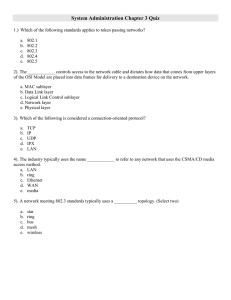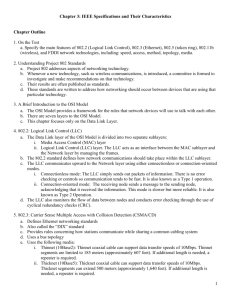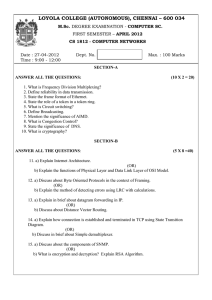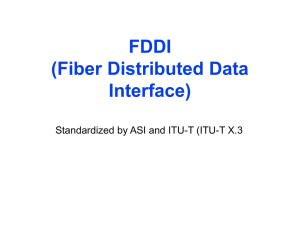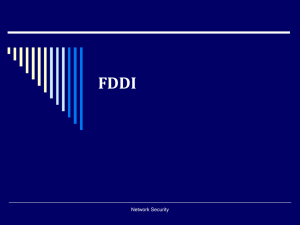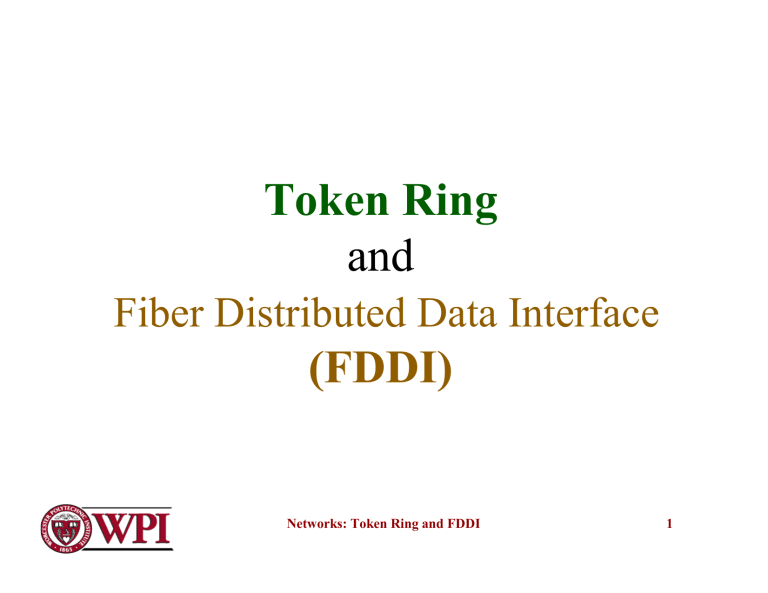
Token Ring
and
Fiber Distributed Data Interface
(FDDI)
Networks: Token Ring and FDDI
1
IEEE 802.5 Token Ring
• Proposed in 1969 and initially referred to as a
Newhall ring.
Token ring :: a number of stations connected by
transmission links in a ring topology. Information
flows in one direction along the ring from source
to destination and back to source.
Medium access control is provided by a small frame,
the token, that circulates around the ring when all
stations are idle. Only the station possessing the
token is allowed to transmit at any given time.
Networks: Token Ring and FDDI
2
Token Ring Operation
• When a station wishes to transmit, it must wait for
token to pass by and seize the token.
– One approach: change one bit in token which transforms it
into a “start-of-frame sequence” and appends frame for
transmission.
– Second approach: station claims token by removing it
from the ring.
• Frame circles the ring and is removed by the
transmitting station.
• Each station interrogates passing frame, if destined
for station, it copies the frame into local buffer.
{Normally, there is a one bit delay as the frame
passes through a station.}
Networks: Token Ring and FDDI
3
Token Ring Network
with star topology
A
Wiring center
E
B
C
Copyright ©2000 The McGraw Hill Companies
Leon-Garcia & Widjaja: Communication Networks
Networks: Token Ring and FDDI
D
Figure 6.58
4
Re-inserting token on the ring
Choices:
1. After station has completed transmission
of the frame.
2. After leading edge of transmitted frame
has returned to the sending station.
The essential issue is whether more than one
frame is allowed on the ring at the same
time.
Networks: Token Ring and FDDI
5
(a)
Low Latency Ring
A
t=0, A begins frame
(b)
A
t=90, return
of first bit
A
A
t=490, reinsert
token
t=400, transmit
last bit
High Latency Ring
A
A
t=0, A begins frame
t=400, last bit of
frame enters ring
A
A
t=840, return of first
bit
t=1240, reinsert
token
Networks: Token Ring and FDDI
Copyright ©2000 The McGraw Hill Companies
Leon-Garcia & Widjaja: Communication Networks
6
Figure 6.59
(a)
Low Latency Ring
A
t=0, A begins frame
(b)
A
t=90, return
of first bit
t=210, return of
header
High Latency Ring
A
A
t=0, A begins frame
t=400, transmit
last bit
A
A
t=400, last bit enters
ring, reinsert token
A
A
t=840, arrival
first frame bit
t=960, reinsert
token
Networks: Token Ring and FDDI
Copyright ©2000 The McGraw Hill Companies
Leon-Garcia & Widjaja: Communication Networks
7
Figure 6.60
IEEE 802.5 Token Ring
• 4 and 16 Mbps using twisted-pair cabling with
differential Manchester line encoding.
• Maximum number of stations is 250.
• Waits for last byte of frame to arrive before
reinserting token on ring {new token after
received}.
• 8 priority levels provided via two 3-bit fields
(priority and reservation) in data and token frames.
• Permits 16-bit and 48-bit addresses (same as
802.3).
Networks: Token Ring and FDDI
8
Token Ring
• Under light load – delay is added due to waiting for
the token {on average delay is one half ring
propagation time}.
• Under heavy load – ring is “round-robin”.
– Performance is fairer and better than Ethernet!!
• The ring must be long enough to hold the complete
token.
• Advantages – fair access
• Disadvantages – ring is single point of failure, ring
maintenance is complex due to token malfunctions.
Networks: Token Ring and FDDI
9
Token Maintenance Issues
What can go wrong?
• Loss of token (no token circulating)
• Duplication of token (forgeries or mistakes)
!The need to designate one station as the
active ring monitor.
• Persistently circulating frame
• Deal with active monitor going down.
Networks: Token Ring and FDDI
10
IEEE 802.5 Token and data frame structure
Token Frame Format
Data Frame Format
1
1
1
SD
AC
2 or 6
Destination
Address
FC
SD
J K 0 J K 0
Access
control
PPP
Frame
control
Ending
delimiter
Frame
status
T
Information FCS
0
0
J K 1 J K 1
C
xx
A
I
C
1
ED
FS
J, K non-data symbols (line code)
FF
frame type
ZZZZZZ control bit
E
x x
I
E
intermediate-frame bit
error-detection bit
A address-recognized bit
xx undefined
C frame-copied bit
Networks: Token Ring and FDDI
Copyright ©2000 The McGraw Hill Companies
1
PPP Priority; T Token bit
M Monitor bit; RRR Reservation
M RRR
Z Z Z Z Z Z
FF
A
4
2 or 6
Source
Address
Starting
delimiter
ED
AC
Leon-Garcia & Widjaja: Communication Networks
11
Figure 6.61
Fiber Distributed Data Interface
(FDDI)
• FDDI uses a ring topology of multimode or single
mode optical fiber transmission links operating at
100 Mbps to span up to 200 kms and permits up to
500 stations.
• Employs dual counter-rotating rings.
• 16 and 48-bit addresses are allowed.
• In FDDI, token is absorbed by station and released
as soon as it completes the frame transmission
{release token after transmission}.
Networks: Token Ring and FDDI
12
FDDI – Dual Token Ring
A
E
B
C
D
Networks: Token Ring and FDDI
Copyright ©2000 The McGraw Hill Companies
Leon-Garcia & Widjaja: Communication Networks
13
Figure 6.62
FDDI Repair
Networks: Token Ring and FDDI
14
FDDI Ring
Operation
Networks: Token Ring and FDDI
15
FDDI
• To accommodate a mixture of stream and bursty
traffic, FDDI is designed to handle two types of
traffic:
– Synchronous frames that typically have tighter delay
requirements (e.g., voice and video)
– Asynchronous frames have greater delay tolerances
(e.g., data traffic)
• FDDI uses TTRT (Target Token Rotation Time)
to ensure that token rotation time is less than some
value.
Networks: Token Ring and FDDI
16
FDDI Data Encoding
• Cannot use differential Manchester because
100 Mbps FDDI would require 200 Mbaud!
• Instead each ring interface has its own local
clock.
– Outgoing data is transmitted using this clock.
– Incoming data is received using a clock that is
frequency and phase locked to the transitions in
the incoming bit stream.
Networks: Token Ring and FDDI
17
FDDI Data Encoding
• Data is encoded using a 4B/5B encoder.
– For each four bits of data transmitted, a corresponding 5bit codeword is generated by the encoder.
– There is a maximum of two consecutive zero bits in each
symbol.
• The symbols are then shifted out through a NRZI
encoder which produces a signal transition whenever
a 1 bit is being transmitted and no transition when a
0 bit is transmitted ! guarantees a signal transition
at least every two bits.
• Local clock is 125MHz. This yields 100 Mbps (80%
due to 4B/5B).
Networks: Token Ring and FDDI
18
FDDI
Networks: Token Ring and FDDI
19
Networks: Token Ring and FDDI
20
FDDI frame structure
Token Frame Format
PRE
SD
FC
ED
Data Frame Format
8
1
PRE
SD
1
FC
2 or 6
Destination
Address
2 or 6
Source
Address
4
Information FCS
1
ED
1
FS
Preamble
Frame
Control
CLFFZZZZ
C = Synch/Asynch
L = Address length (16 or 48 bits)
FF = LLC/MAC control/reserved frame type
Leon-Garcia & Widjaja: Communication Networks
Networks: Token Ring and FDDI
Figure 6.63
21
More FDDI Details
• Transmission on optical fiber requires ASK
• The simplest case: coding is done via the absence or
presence of a carrier signal {Intensity Modulation}.
• Specific 5-bit codeword patterns chosen to guarantee
no more than three zeroes in a row to provide for
adequate synchronization.
• 1300 nm wavelength specified.
• Dual rings (primary and secondary) – transmit in
opposite directions.
• Normally, second ring is idle and used for redundancy
for automatic repair (self-healing).
Networks: Token Ring and FDDI
22
Differences between 802.5 and FDDI
•
•
•
•
•
•
•
Token Ring
Shielded twisted pair
4, 16 Mbps
No reliability specified
Differential Manchester
Centralized clock
Priority and Reservation
bits
New token after receive
•
•
•
•
•
•
•
FDDI
Optical Fiber
100 Mbps
Reliability specified (dual
ring)
4B/5B encoding
Distributed clocking
Timed Token Rotation Time
New token after transmit
Networks: Token Ring and FDDI
23


